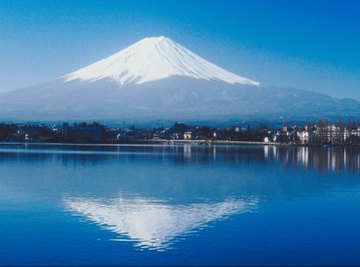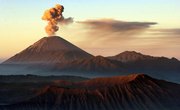
There are three primary types of volcanoes, each with unique physical characteristics and eruptive natures. Composite volcanoes are explosive, towering giants. Shield volcanoes quietly produce broad, massive structures through lava flows. Cinder cone volcanoes are the smallest and simplest, but still pack a volcanic punch.
Composite Volcanoes
Composite volcanoes, also referred to as stratovolcanoes, represent the classic shape most associated with a volcano. They tower over the landscape, rising to elevations of more than 10,000 feet. They are also the most common type of volcano on Earth, accounting for approximately 60 percent of the planet’s volcanoes. They feature steep, upwardly concave sides and either a central vent or a cluster of vents at their summit. Their gas-rich andesite lava makes their eruptions explosive. As their name suggests, they are formed by alternating layers of hardened lava and pyroclastic material. In addition to their explosivity, composite eruptions typically plinian in nature, meaning they produce large eruptive columns that inject gases and particles high into the atmosphere.
Shield Volcanoes
Shield volcanoes are constructed almost entirely out of lava flows. Unlike composite volcanoes, shield volcanoes produce eruptions of very fluid basaltic lava. This lava flows out of vents in all directions, traveling long distances before solidifying. They are characterized by broad, gently sloping cones, resembling a soldier’s convex shield. They are commonly associated with a high magma supply rate, fueling a continuous flow of lava on the surface. Lacking any real explosivity, these ongoing eruptions take the form of lava fountains. Over time, shield volcanoes can become extremely large, producing islands in the middle of the ocean.
Cinder Cone Volcanoes
Cinder cone volcanoes are much smaller than either composite or shield volcanoes, typically rising no higher than 1,000 feet. They feature straight sides, with a steep slope of 30 to 40 degrees. They are typically circular, with a large bowl-shaped cater at the summit. Like shield volcanoes, cinder cone volcanoes eject basaltic lava. However, their lava is slightly thicker and contains more trapped gases. This gas results in small explosions that break the lava into smaller blobs, known as tephra. This tephra solidifies before it reaches the ground, producing piles of lava rocks around the vent. These cinder-like materials are where the volcanoes get their name. Because these volcanoes are constructed of loose tephra, they often produce lava flows from their base.
Volcano Examples
Mount St. Helens is an example of a composite volcano. During the highly explosive 1980 eruption, the volcano experienced a large sector collapse that left a horseshoe-shaped crater. Mauna Loa, in Hawaii, is an example of a shield volcano. This volcano is the largest volcano on Earth, with a volume of 19,000 cubic miles and an area that covers 2,035 square miles. The Paricutin volcano, in Mexico, is an example of a cinder cone volcano. This volcano erupted out of a farmer's field in 1943, eventually covering 100 square miles in ash and 10 square miles in lava flows over a nine-year period.
References
About the Author
Doug Bennett has been researching and writing nonfiction works for more than 20 years. His books have been distributed worldwide and his articles have been featured in numerous websites, newspapers and regional publications. Bennett's background includes experience in law enforcement, the military, sound reinforcement and vehicle repair/maintenance.
Photo Credits
Jupiterimages/Photos.com/Getty Images
